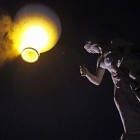
More college football: Conference Predictions | Dennis Dodd | Jeremy Fowler
ATLANTA -- First and foremost, know this: This isn't your father's Hall of Fame.
Often ignored for nearly two decades in South Bend, Ind., the College Football Hall of Fame in Atlanta represents today's game and media world while respectfully giving a nod to the past. The National Football Foundation's decision in 2009 to move the Hall of Fame into the deep South symbolizes how the sport has changed demographically and through television.
Located within a five-minute walk from the Georgia Dome and the future Atlanta Falcons stadium, the Hall of Fame craves connectivity and a personal experience above all else. There are interactive videos and games, selfies with digital face paint, countless screens, and a field for activities and events. This being 2014, of course, there's also product placement within exhibits by the sponsors, who largely funded the $68.5 million project that opens Aug. 23 after a two-year delay.
Even the reverential room where the actual Hall of Famers are honored takes on a new twist, losing the plaques in exchange for touchscreen media content. Most of the building, Hall of Fame CEO John Stephenson said, is simply a "big, crazy college football playground" at $20 per adult.
CBSSports.com recently got a two-hour tour of the Hall of Fame, which remains a work in progress a week before opening.
The Quad
You will enter the museum through a tunnel as if you're walking onto a field. Large-paneled photographs of the previous year's conference champions will greet you as you hear the click-clack of cleats walking in the tunnel. The crowd noise will intensify as you near the end of the tunnel.
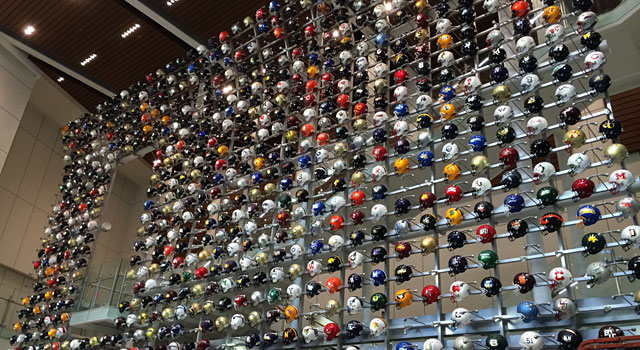
What follows next is a 40-foot-high wall with more than 700 football helmets representing every Division I, Division II, Division III and NAIA program. “People come in here and just stare at this thing for 10 minutes,” Stephenson said.
Schutt, the sports-manufacturing company that made the helmets, had contracts with only about 200 schools. So for the remaining teams, helmets got painted with the right color, and a Hall of Fame intern spent six months asking every school for one set of helmet stickers.
Upon entering the lobby (called "The Quad"), you can register with the Hall of Fame to get a personalized experience. Your school's helmet will light up. RFID chips are embedded in the museum ticket telling the Hall who you cheer for so you can receive school-specific content and activities during your visit (and, naturally, collect your information for the Hall).
"We're not going to pound people with emails," Stephenson said. "But it helps keep us engaged with our fans. Most people won't give out personal information because they don't like to. Even if you don't register with us, this chip will do things. If you register, this just makes it more personal so everywhere you go in the building, the school knows who your school is. It saves you time."
The personalized approach goes to the heart of college football that sometimes gets ignored. Yes, college football has grown nationally through TV, the Bowl Championship Series and now the College Football Playoff. But at the game's core, fans are fans of their schools first and foremost.
The Playing Field
A 45-yard field spanning 15,000 square feet will feature various activities on a daily basis. You can try to kick a field goal, test your throwing accuracy, and complete an obstacle course.
Above the field is a massive video screen that will show live games and highlights. When the field is not used during normal hours, it can accommodate 900 people for a sit-down meal and up to 1,450 for a reception. The field is one of four areas the Hall will rent out for private events, and it has 35 such contracts so far, Stephenson said.
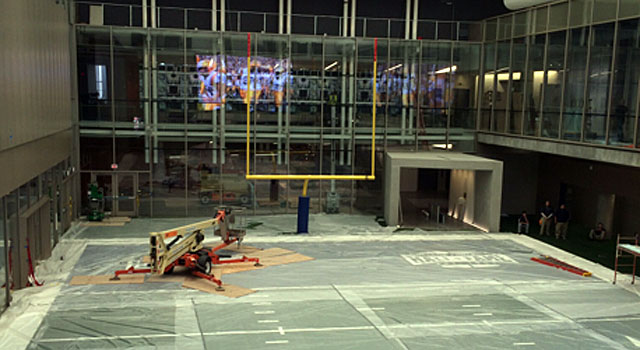
Outside the field is a Why We Love College Football gallery -- a 52-foot long touchscreen, interactive wall that calls up your team's traditions, highlights and pictures. There are trophies and kiosks that show national championship information that's personalized by school. (Sorry, Alabama. The Hall of Fame's historian counts the Crimson Tide's national titles at 13, not the 15 claimed by the university.)
Game Day Theater
A 10-minute film narrated by Hall of Famers will play inside a 150-seat theater that uses the new HDTV technology called 4K. It's designed to give viewers the feel of what a game-day experience is like.
The Hall of Fame's production company spent three years shooting about 23 games in 4K for the high-resolution film, which can be heard in surround sound. New footage could be added each year. "You feel like you're at the game," Stephenson said.
Fans' Game Day Gallery
To build and operate the 94,000-square-foot Hall of Fame, Atlanta Hall Management received $1 million from Atlanta and the rest from private sponsors and donors and bank loans, Stephenson said. The museum's sponsor names, although not horribly in your face, have a constant presence. Somehow that seems fitting given how we view college football in a commercialized vacuum today.
(The National Football Foundation heavily promotes a theme at the museum: Football builds leaders and productive, self-starting citizens. In one gallery, sponsored by Chick-fil-A, famous people such as Tommy Lee Jones and Tom Brokaw explain they're successful in part because of playing football.)
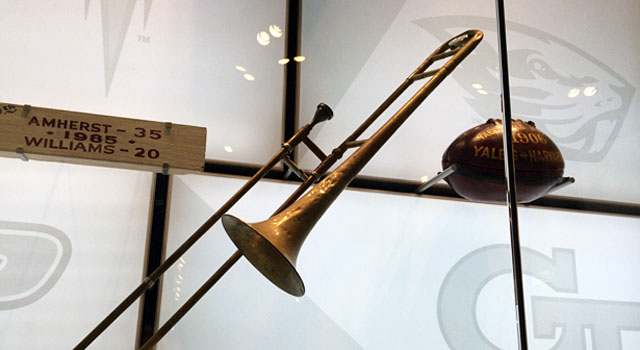
Coke, Chick-fil-A, Kia, AT&T and the Chick-fil-A Peach Bowl are the gallery sponsors as founding partners, and 11 other companies have sponsorships. Coke's Game Day gallery is a more light-hearted area where you can digitally paint your face or compete in electronic games.
You can interactively play tradition trivia, a cheerleader challenge or even design your own marching band routine and see it play out with music. Points are added up by each participant's favorite school -- there's that chip in your ticket again -- to keep a running tally by team.
In another nod to the times, the Hall of Fame lets you be a guest picker on ESPN's College GameDay (in the Home Depot section, of course). You'll be superimposed onto a screen between broadcasters Chris Fowler and Desmond Howard and then digitally have a mascot's head cover your face once you make your pick, as if you're Lee Corso.
Building a Champion Gallery
This area is for more hard-core fans. There's an exhibit devoted to coaches who innovated the game: Frank Beamer (special teams); Pop Warner (single wing); Bud Wilkinson (5-2-4 defense); Clark Shaughnessy (T-formation); Jerry Claiborne (wide tackle defense); Emory Bellard (wishbone); Joe Gilliam Sr. (nickel defense, bump and run); Chris Ault (pistol offense); and George Perles (stunt 4-3 defense).
On a wall, Atlanta Journal-Constitution cartoonist Mike Lukovich drew cartoons of 14 iconic coaches next to an entertaining quote. Bear Bryant's quote: "If you walk the heavenly streets of gold, you gotta know the password, 'Roll, Tide, Roll!'"

How interactive is the museum? Plays drawn out by John Heisman on a lumber company book in 1905 were scanned into a kiosk with his actual handwriting. Heisman's nephew owns the playbook and allowed it to be scanned, not kept or borrowed. "I don't blame him," Stephenson said.
Nearby, you can read recruiting questionnaires that eight players -- Peyton Manning, Orlando Pace, Danny Wuerffel, Tony Gonzalez, Jonathan Ogden, Hines Ward, Eric Crouch and LeBron James -- wrote about themselves in high school. LeBron noted he was a 6-foot-8, 232-pound wide receiver with a 2.8 grade-point average and a 4.6 time in the 40.
Elsewhere, a Hall of Fame coach teaches you a play on video. Learn the pistol from Ault, the wishbone from Barry Switzer, the option from Lou Holtz, the pro set from Terry Donahue, the I-formation from John Robinson, and the air ball from Steve Spurrier. Stay awake during the lesson. They're going to quiz you later.
Game Time Gallery
This area is devoted to college football's passion. You can be a broadcaster and make a call from a famous play. You can learn about college football rivalries (there are eight on permanent display: Alabama-Auburn, Harvard-Yale, Army-Navy, Notre Dame-USC, Grambling-Southern, Texas-Oklahoma, Cal-Stanford and Michigan-Ohio State).
In the "Anatomy of a Play" exhibit, you will see and hear from quarterbacks and coaches on what happens during the six seconds before the ball is snapped. A 360-degree virtual stadium exhibit allows you to be on the field from various angles at a legendary stadium, sometimes even as the players and marching band run onto the field.
"We had a number of companies pitch us that the 360 should be virtual reality, which you could do with that footage," Stephenson said. "But as soon as you buy that, it's out of date in six months and you're old. So while it seems very techy in here, it's all just a bunch of screens. You can change the content behind the screens just like that."
Actual Hall of Fame
The museum's lobby is designed so you see a stair case leading to the top of the building, which is shaped like a football. The stairs are a reminder to eventually visit the actual Hall of Fame, the nicest room in the building given its finished floors and wood on the walls.
While much of the museum serves as a playground, the intent is for there to be a reverential feel -- with a 21st Century twist -- in the room where inductees are honored. The names of Hall of Famers are etched into glass. Gone are the plaques from South Bend, replaced by 10, 55-inch touchscreens on swivels.
Antennas reading your ticket will immediately call up all of the Hall of Famers from your school. Depending on what's available, the content on the screen could include photos, highlights, and media interviews of the Hall of Famer. (An inductee from the pre-video days will at least have a photo.) You can scroll through any school you want.
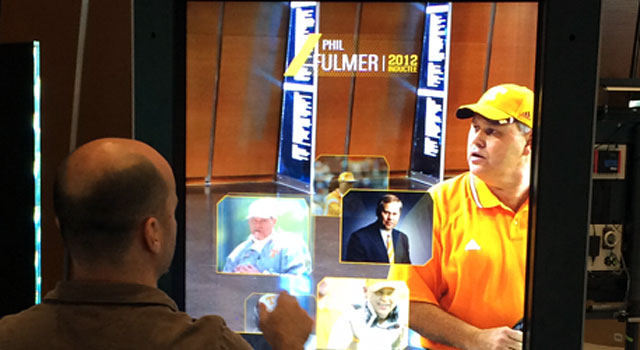
Stephenson said several Hall of Famers signed off on this unique change.
"One guy said, 'This is cool because I can bring my grandson here and he can see me, not just a piece of plastic that looks like me,'" Stephenson said. "The ones we talked to felt very, very honored by it. It's sufficiently reverent so it's not too tricked up. There aren't holograms. We didn't want to be just a virtual Hall of Fame. We built this room like it's a cathedral."
Business model
The Hall of Fame's business model is based on 500,000 visitors a year -- the figure it projects for the fourth year after peaking in Years 1 and 2, Stephenson said. By comparison to the Hall's nearby neighbors, Atlanta annually draws 2.2 million visitors to the Georgia Aquarium, more than 1 million to the World of Coca-Cola, 300,000 to the CNN Center studio tour, and 200,000 to the Children's Museum.
The College Football Hall of Fame's attendance has struggled at various locations. When the Hall opened in Kings Mills, Ohio, in 1978, there were predictions of annual attendance at 300,000, but after a first year of 80,000 visitors, crowds slumped to about 30,000 per year, according to a 2011 article by The Cincinnati Enquirer.
In 1995, supporters of the Hall predicted it would attract more than 150,000 visitors a year in South Bend due to its proximity to Notre Dame. Instead, the attraction drew 115,000 in the first year and about 60,000 annually after that, The Associated Press reported in 2009.
Now, Atlanta adopts the Hall with attendance projections that Stephenson said were selected in the "mid-to-high range" based on two studies. Stephenson said helping the museum is that it's located in a thriving district where fans walk to and from a football stadium, it's in a large alumni city for many colleges and has a major airport, and it's in the college football-crazy Southeast region.
"I'm totally biased, but if you're going to put a college football-themed attraction somewhere in America, it would be on this two-acre parcel," Stephenson said. "We don't want this to be a bucket-list place. We want you to come every time you're in Atlanta, especially if you're here for a football game."
The Hall of Fame has a room set aside for temporary exhibits. Only about one-quarter of the Hall's artifacts are currently on display. If, for example, Alabama is playing Georgia in Atlanta, Stephenson wants artifacts and memorabilia from those schools on display in exhibits and in the gift shop, which is accessible without paying admission to the museum.
"We've got to be flexible to our fan bases, and that's something museums typically don't do," Stephenson said.
Ticket prices are $19.99 for adults, $17.99 for students, and $16.99 for kids ages 3 to 12 and seniors 65 and older. Kids under 3 are free. According to Stephenson, a survey showed people who identify themselves as big college football fans said they would pay more than $20 for a ticket compared to about $15 for less-enthusiastic fans.
Atlanta won the College Football Hall of Fame over Dallas in 2009, but the opening got delayed two years due to a decline in fundraising during a down economy. Chick-fil-A Peach Bowl CEO Gary Stokan pulled out overseeing the project and turned it over to Stephenson, a corporate lawyer who started representing the bowl game in 2005.
"We think we know how this building is going to run, but we really don't know," Stephenson said. "We'll have to make some adjustments here and there. We'll be right about some things, wrong about some things."
This much seems clear: Atlanta built a 21st Century Hall of Fame for college football unlike anything the sport has seen.
College Football Hall of Fame & Chick-fil-A Fan Experience Intro Video from College Football Hall of Fame.













